Low-tide walk to sample low-hanging fruit
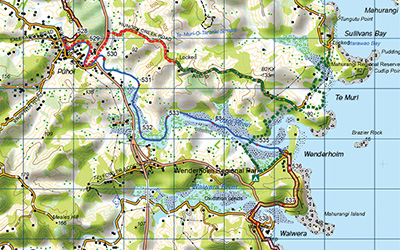
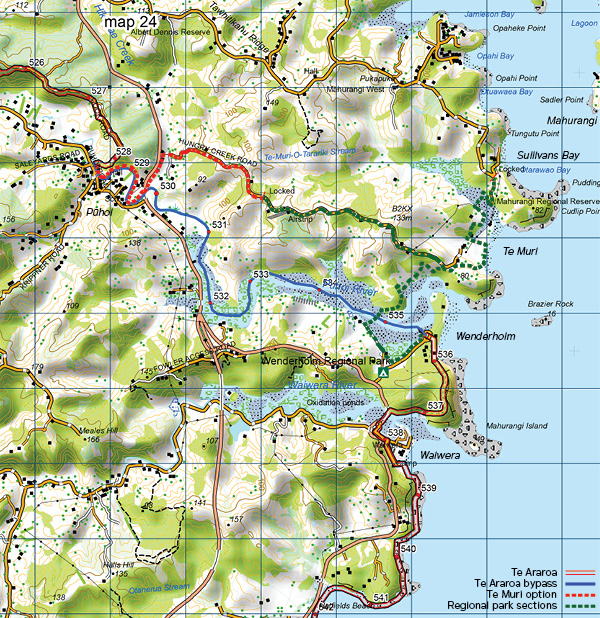
Lucky Break: Stymied in its plans to run the national walkway along the south bank of the Pūhoi River, Te Araroa Trust could take advantage of the purchase of Te Muri and to provide an even better walking route, through the heart of a 900-hectare regional park—and one that wasn’t dogged by State Highway 1 for two kilometres. Conceptual Te Muri option Mahurangi Magazine Underlying maps Te Araroa Trust
Mahurangi can best ease the region’s growing pains by not housing its share of Aucklanders.
According to the introductory video on the new unitary plan website, Aucklanders want a high quality, more compact city, in the face of the expected 30-year growth rate of 600 people per week; a million more people.
But growth is only part of the problem. Since its 1955 Master Transportation Plan, the city has been heading down a dead-end motorway. Motorways becoming ‘renewable’ through biofuels, fuel cells, better batteries, or by some mythical hydrogen economy is a green illusion—their only, partial, redemption is as conduits for trolley buses, and trolley lorries. Only by radically reshaping itself as a walkable city, can Auckland become the global green capital it should aspire to be, rather than the all-things-to-all-people ‘World’s most liveable city’.
The introductory video reports that Aucklanders want to be walking distance from parks. But they particularly rate their regional parks as the jewel in the crown of an Auckland rich in natural endowments, and can form long queues to get into those nearest, on summer holidays. This highlights the uncomfortable fact that the regional park network is shaped by the same car-centric thinking behind the Master Transportation Plan. Fortunately, some parks are ripe for the provision of public transport.
There is more to making regional parks accessible to public transport than providing a bus service, otherwise thousands wouldn’t have sat in cars for up to two hours waiting to enter Long Bay Regional Park on New Year’s Day, despite there being a bus stop 76 metres from the park entrance. The secret of successful public transport is providing a superior experience, as compared to the lot of the private car user. For example, those sweeping by barely moving motorway traffic on the staggeringly successful Northern Busway of a morning have every reason to feel that they are the first class citizens, rather than the losers that bus users are generally be made to feel.
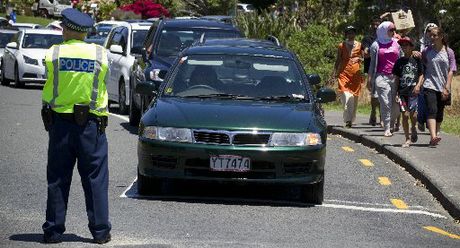
Parks for Cars or People: It is deeply ironic that regional parks are being declared full, when in fact they are full of cars, rather than the people they were purchased to for. At Long Bay Regional Park on New Year’s Day, police were deployed to enforce the one-out-one-in measure necessary. photographer Greg Bowker
A bus from midtown to Long Bay can take more than an hour. From the same starting point, in about the same time, express bus passengers can be outside Waiwera, on the southern boundary of 900 hectares of regional parkland. If the bus continued into the park and dropped passengers within 130 metres of the beach, as it once did, passengers would be the first-class park users, not those sitting in this summer’s queues on State Highway 17 hoping that Wenderholm’s gates won’t close before they get to squeeze inside.
The greatest regional parks opportunity to put public transport users in the box seats, and send a clear message that Auckland Council is serious about shaping a high-quality compact city, is Te Muri. Purchased in the dying days of the regional council for an eye-watering $15 million, the 407-hectare potentially links State Highway 17 with the coastal Te Muri parkland acquired in 1973. All that stands in the way is the not inconsiderable cost of upgrading the narrow farm road that winds along the ridgeline, between the Pūhoi and Te Muri catchments. But to build such a road would be to pass up a golden opportunity to reward the walkers, by retaining Te Muri as the vehicle-free haven the park has been these forty years. Although it was not officially opened until 1988, the resident farm manager, Peter Baker, kindly gave locals the run of the place. This resulted in a cohort developing that strongly appreciated the splendid sense of isolation that is experienced when vehicle access is absent. Subsequently, when the citizens advisory group that was part of the management plan process in that era began its deliberations, it was presented with a well researched, strongly argued and attractively illustrated case for developing Te Muri for walking access only. The advisory group, chaired by co-founder of the regional parks Justice Arnold Turner, was wholeheartedly convinced, and parks staff plans to build a concrete road bridge across the estuary from Mahurangi West and provide parking for 2000 cars were scotched.
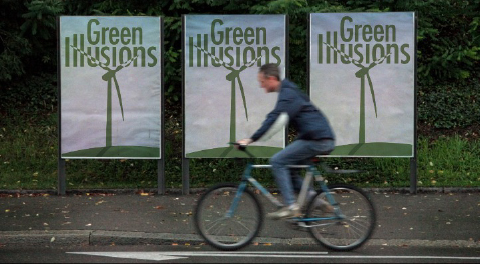
For a Mere $1.4 Quadrillion: ‘If actual installed costs for solar projects in California are any guide, a global solar program would cost roughly $1.4 quadrillion, about one hundred times the United States GDP. Mining, smelting, processing, shipping, and fabricating the panels and their associated hardware would yield about 149 100 megatons of CO2. And everyone would have to move to the desert, otherwise transmission losses would make the plan unworkable.’ image Green Illusions
Central to the case for developing the area for walking access only was the concept of a Mahurangi coastal trail, to link Te Muri to Wenderholm, immediately to the south across the Pūhoi River. But rather than embrace the concept, a miffed regional parks manager cried poverty when urged to begin a detailed study of the proposal, much less tackle the straightforward task of placing an unobtrusive wooden walk bridge across the diminutive Te Muri, where it narrows. Yet right up until that point, there had apparently been funds assured to send a concrete road bridge sailing across the estuary, at about its widest point.
That was 1987, the year before the world should have been yanked awake to the full enormity of the global addiction to fossil fuels by Dr James Hansen’s congressional testimony:
Number one, the Earth is warmer in 1988 than at any time in the history of instrumental measurements. Number two, the global warming is now large enough that we can ascribe with a high degree of confidence a cause and effect relationship to the greenhouse effect. And number three, our computer climate simulations indicate the greenhouse effect is already large enough to begin to effect the probability of extreme events such as summer heat waves.
No city is going to be particularly liveable in a climate disrupted by anthropogenic global warming, but cities have the greatest opportunities, and the moral responsibility, to radically reduce greenhouse gas emissions and to become substantially more resilient. For Christchurch, that patently requires re-building on land both higher and less prone to liquefaction, and developing the poor old low-lying quake-damaged city as a national park—but that ship is sailing. But even for the Auckland region, sea-level rise will become excruciatingly costly. Although the five-metre rise possible this century won’t signal game over as is will in Christchurch, the long-term future of the isthmus, post the ice-sheet melt that is now unstoppable, is as seabed.
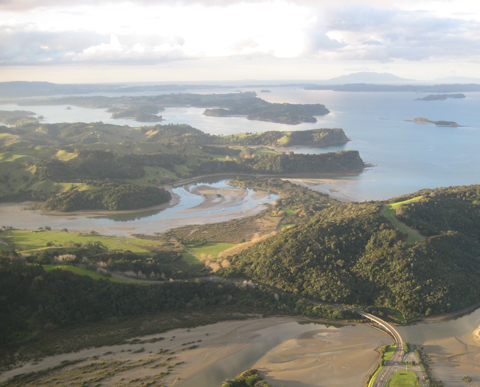
Low-Hanging Public Transport Park Access: For less than 0.04% of the cost of the planned Pūhoi–Wellsford motorway, a footbridge could cross the Pūhoi River to open up a coastal walkway that would rate as a national treasure. No overseas tourist dollars are ever going to flood into the country on the appeal of an extra 38 kilometres of motorway. image ImageShack
To be liveable, in the face of a potentially crippling imperative to be low-emission, requires an urgent end to growth and consumerism. An end to growth requires that the children inheriting this runaway industrial age take responsibility for throttling back demand with an all-but-total breeding moratorium. But it is consumerism that the regional parks can do most about. One of the great rewards for living in walkable communities, without private cars, must be to be a short bus ride away from the heart of a regional park, and a bus ride away from any regional park.
These frequent references to buses will rankle with rail advocates. But what the region has in spades is a surplus of roads, even without spending $1.65 billion on a ‘holiday highway’ to further lock in the region’s contribution to global greenhouse gas emissions. Modern trolley buses have the flexibility to form the backbone of a Brown master transportation plan that could be implemented within a decade. Meantime, come the election in November, and urban rail, for most Aucklanders, will remain a myth.
A liveable compact city requires that its populace can readily enjoy the coast and the country. Mahurangi’s duty to the region is to retain its natural and rural landscape of outstanding natural beauty, as is Warkworth’s not to become a satellite growth centre.
For a few enthusiasts, next Sunday’s second annual walk will confirm that the Mahurangi Coastal Trail would harvest the lowest of the low-hanging public transport regional park access fruit—900 hectares of Wenderholm, Te Muri and Mahurangi parkland.
And the quinces and figs are ripe, along the way.
